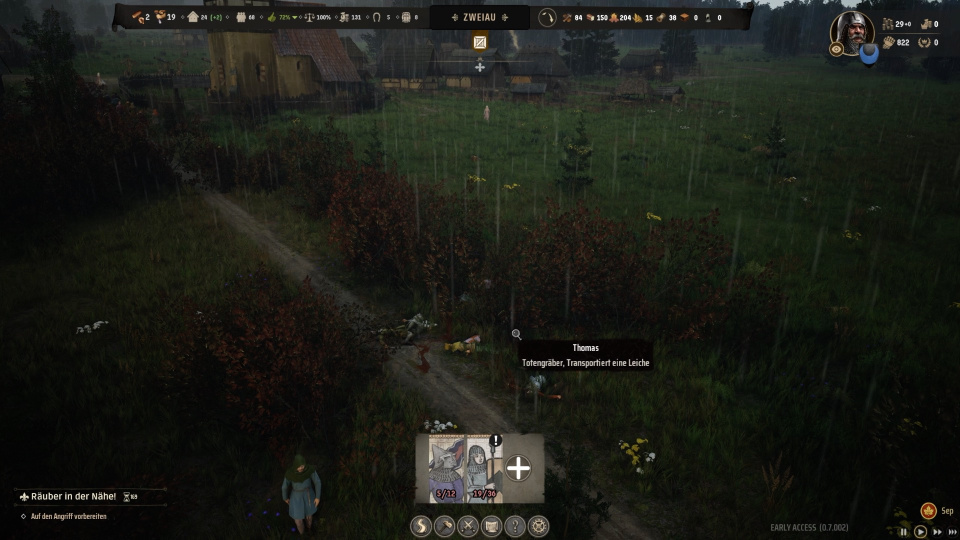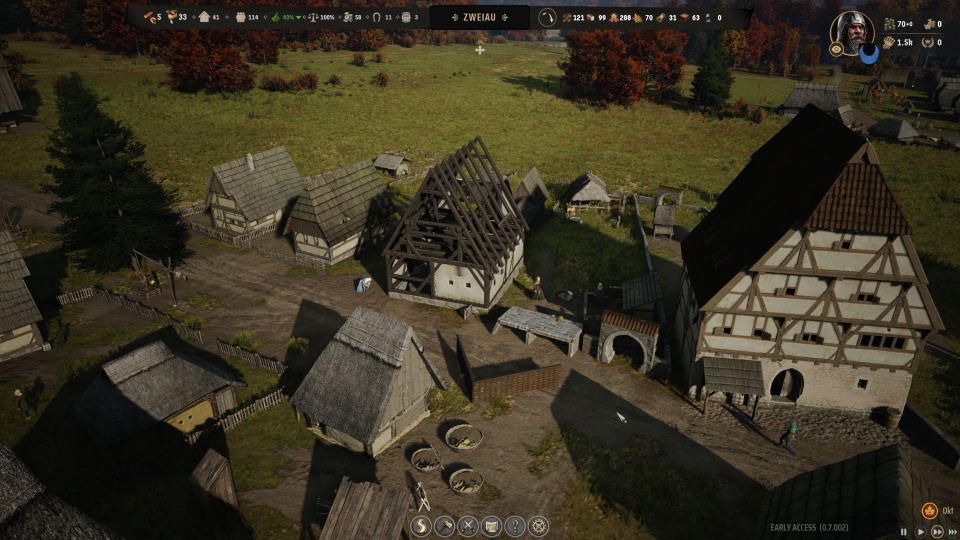Teasers
There's a bit of Stronghold in this building game, plus Banished, Anno and even Total War – but the result is very unique. But for whom is it worth getting started in Early Access?
Advertisement
 |
All screenshots and video scenes come from GamersGlobal
In the building game community Manor Lords eagerly awaited. If you haven't heard the hype: In this title you build a medieval village and develop it into a city. You expand into neighboring lands, where you build additional locations and, on top of that, you also fight detailed real-time strategy battles against robbers or competitors. So there's a lot that comes together. On top of that, Manor Lords, developed with Unreal Engine 4, looks outrageously good, especially when you consider that there is a single solo developer behind developer Slavic Magic.
 |
| Here you can see a settlement with a lively town center around the church and market square with outsourced quarters for farmers, lumberjacks, shepherds and foresters after around nine hours of play. |
At first everything is missing
There is currently only one map without rivers or lakes, which is divided into nine areas. Resources such as berry bushes, clay and ore are distributed randomly – your starting point is also determined by chance, which with a bit of bad luck can lead to significant disadvantages (and thus a restart). You have the choice between a peaceful mode (you win if you have so many residents in a town that it rises to the “Big City” level), a kind of horde scenario in which you have to survive all robber attacks and the default mode Scenario in which you initially build peacefully and only occasionally have to fend off robbers. To win here, you have to control all regions, which amounts to a war with the one competitor on the map.
It will take some time before you expand. You start with nothing but a handful of families (usually consisting of three people, although there are no models of children in the village). You will be the first to build farmsteads so that these starting workers have a roof over their heads and the satisfaction level does not continue to decline due to homelessness. When planning the first farmsteads, there is a big special feature of Manor Lords: Here you are very free in the placement, there is no grid of squares in the background that creates a right-angled settlement. Roads are one of the few building options that you can build for free and that appear immediately. Thanks to the pleasant automatic adaptation of the roads to the surroundings, even natural-looking crooked and crooked paths are no problem. You place many buildings the same way as in other building games, but for houses, fields and the market square you instead mark a building area with four corner points. The area marked in this way also automatically adapts to the street and other buildings. For example, you create trapezoid-shaped farmsteads at a bend in the road.
Advertisement
 |
| The fallen must be buried after a skirmish to prevent disease from spreading. You can also have robbers buried in your cemetery, but space seems to be limited. Alternatively, you can build a corpse pit for aggressors. |
See how they carry their burdens
Manor Lords draws on many genre colleagues. Clicking on a homestead brings it up Annofactor comes to light. Farmsteads get water from wells and everything they need from the market place: food, clothing, firewood. They also want a church. If all of these needs are met, you can level up the homestead and thus the residents (currently there are only three levels). Level 2 residents bring the region one silver coin every month, but this also adds new demands such as beer from the tavern.
 |
| It's fun to watch new buildings being constructed because the detailed models are put together in many modular steps. Since the “odor filter” isn't working yet, no residents have complained about the tannery across the street. |
Scurrying and fighting
A good part of the fun of building Manor Lords is the joy of watching. In that respect, the title reminds me most Stronghold. Although there are no decorative animations to set the mood like the drunks at the tavern in the Firefly classic, I can zoom in really close thanks to the 3D graphics. Stronghold also reminds you that new workers do not spawn directly in new houses, but only a new family moves into the village at the beginning of a month if the satisfaction is over 50 percent (even two at over 75 percent). Clearing the 50 percent hurdle is not so difficult as soon as no one is homeless anymore and the church (which is not dependent on any resources) produces satisfaction.
Also like Stronghold, construction and military are closely linked. Residents bring home weapons, shields and optional other equipment from the camp. If I raise a militia, the more equipment I have produced and stored, the better it will be. A pinch of Total War can be seen in the battles. Squads have a morale value and you can order tactics such as an assault or rearguard action. The effectiveness value is particularly interesting. This decreases, for example, during marches without a break, but also due to environmental factors. This feature is so pronounced that I can still win a battle despite being outnumbered. If a squad engages the enemy in a favorable position and others stab them in the back, the encirclement and disadvantageous terrain massively reduce the effectiveness of the enemy. Raising your militia takes place immediately, but not being prepared and mobilizing your troops at the last second in the event of an impending attack has significant disadvantages: the troops start out already tired and have just been called up, with a penalty on “cohesion”, which increases over time turned into a bonus. Veterans also provide an experience bonus to effectiveness.
 |
| You can see the morale value, the efficiency and an icon for each squad with the number of units. However, there is no life bar or a permanent arrow to mark the last marching orders. |